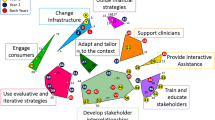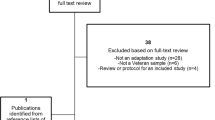ABSTRACT
The Veterans Health Administration (VHA) is the largest single provider of medical care to people with hepatitis C (HCV) in the USA. Given the advent of promising new HCV therapies, the VHA is now faced with a large number of chronically HCV-infected veterans with concomitant psychiatric or substance use comorbid conditions who will need to either be retreated or newly treated for HCV or will require management for chronic liver disease. There is a critical need in the VHA for behavioral medicine and hepatology specialists, along with infectious disease and primary care providers with an interest in hepatitis C, to provide coordinated care for these complex patients. The VHA Health Services Research and Development Service has advocated for the application of strong implementation science theories and methods to translate new models of healthcare delivery in clinical practice. To inform the delivery and evaluation of integrated behavioral medicine and specialty care for vulnerable patient populations, we sought to develop an enriched framework which incorporates implementation science theory and strong conceptual models for access to care. In this paper, we present a hybrid conceptual framework that accomplishes this goal. To illustrate how this hybrid model could inform the translation of a novel method of healthcare delivery, we provide a case study of a VHA initiative to improve access to integrated behavioral medicine and specialty care among veterans with HCV.

Similar content being viewed by others
References
Dominitz JA, Boyko EJ, Koepsell TD, et al. Elevated prevalence of hepatitis C infection in users of United States veterans medical centers. Hepatology. 2005;41(1):88-96.
Butt AA, Justice AC, Skanderson M, Rigsby MO, Good CB, Kwoh CK. Rate and predictors of treatment prescription for hepatitis C. Gut. 2007;56(3):385-389.
Kanwal F, Hoang T, Spiegel BM, et al. Predictors of treatment in patients with chronic hepatitis C infection—role of patient versus nonpatient factors. Hepatology. 2007;46(6):1741-1749.
Backus LI, Boothroyd DB, Phillips BR, Mole LA. Predictors of response of US veterans to treatment for the hepatitis C virus. Hepatology. 2007;46(1):37-47.
Rongey C, Hamilton N, Asch S, Knight S. Impaired access to liver specialty care among rural veterans with hepatitis C. 28th Annual HSR&D National Meeting. Washington, DC; 2011.
Kanwal F, Hoang T, Kramer JR, et al. Increasing prevalence of HCC and cirrhosis in patients with chronic hepatitis C virus infection. Gastroenterology. 2011;140(4):1182-1188.e1.
PHSHG. Seattle VAMC. Reports from the VHA Liver Disease Database; 2010
el-Serag HB, Kunik M, Richardson P, Rabeneck L. Psychiatric disorders among veterans with hepatitis C infection. Gastroenterology. 2002;123(2):476-482.
Bacon BR, Gordon SC, Lawitz E, et al. Boceprevir for previously treated chronic HCV genotype 1 infection. N Engl J Med. 2011;364(13):1207-1217.
Marcellin P, Forns X, Goeser T, et al. Telaprevir is effective given every 8 or 12 hours with ribavirin and peginterferon alfa-2a or -2b to patients with chronic hepatitis C. Gastroenterology. 2011;140(2):459-468.e1. quiz e14.
Pawlotsky JM. The results of phase III clinical trials with telaprevir and boceprevir presented at the Liver Meeting 2010: a new standard of care for hepatitis C virus genotype 1 infection, but with issues still pending. Gastroenterology. 2011;140(3):746-754.
Kwo PY, Lawitz EJ, McCone J, et al. Efficacy of boceprevir, an NS3 protease inhibitor, in combination with peginterferon alfa-2b and ribavirin in treatment-naive patients with genotype 1 hepatitis C infection (SPRINT-1): an open-label, randomised, multicentre phase 2 trial. Lancet. 2010;376(9742):705-716.
Butt AA, Wagener M, Shakil AO, Ahmad J. Reasons for non-treatment of hepatitis C in veterans in care. J Viral Hepat. 2005;12(1):81-85.
Bini EJ, Brau N, Currie S, et al. Prospective multicenter study of eligibility for antiviral therapy among 4,084 U.S. veterans with chronic hepatitis C virus infection. Am J Gastroenterol. 2005;100(8):1772-1779.
Craig TJ, Petzel R. Management perspectives on research contributions to practice through collaboration in the U.S. Veterans Health Administration: QUERI Series. Implement Sci. 2009;4:8.
Stetler CB, Mittman BS, Francis J. Overview of the VA Quality Enhancement Research Initiative (QUERI) and QUERI theme articles: QUERI Series. Implement Sci. 2008;3:8.
Sales A, Smith J, Curran G, Kochevar L. Models, strategies, and tools. Theory in implementing evidence-based findings into health care practice. J Gen Intern Med. 2006;21(Suppl 2):S43-S49.
QUERI Implementation Guide. 2009. http://www.queri.research.va.gov/implementation/section_1/part1d.cfm.
Rycroft-Malone J, Harvey G, Seers K, Kitson A, McCormack B, Titchen A. An exploration of the factors that influence the implementation of evidence into practice. J Clin Nurs. 2004;13(8):913-924.
Davies P, Walker AE, Grimshaw JM. A systematic review of the use of theory in the design of guideline dissemination and implementation strategies and interpretation of the results of rigorous evaluations. Implement Sci. 2010;5:14.
Kitson A, Harvey G, McCormack B. Enabling the implementation of evidence based practice: a conceptual framework. Qual Health Care. 1998;7(3):149-158.
Kitson AL, Rycroft-Malone J, Harvey G, McCormack B, Seers K, Titchen A. Evaluating the successful implementation of evidence into practice using the PARiHS framework: theoretical and practical challenges. Implement Sci. 2008;3:1.
Graham ID, Logan J. Innovations in knowledge transfer and continuity of care. Can J Nurs Res. 2004;36(2):89-103.
Kilbourne AM, Neumann MS, Pincus HA, Bauer MS, Stall R. Implementing evidence-based interventions in health care: application of the replicating effective programs framework. Implement Sci. 2007;2:42.
Lukas CV, Holmes SK, Cohen AB, et al. Transformational change in health care systems: an organizational model. Health Care Manage Rev. 2007;32(4):309-320.
Glisson C, Schoenwald SK. The ARC organizational and community intervention strategy for implementing evidence-based children’s mental health treatments. Ment Health Serv Res. 2005;7(4):243-259.
Glisson C, Landsverk J, Schoenwald S, et al. Assessing the organizational social context (OSC) of mental health services: implications for research and practice. Adm Policy Ment Health. 2008;35(1–2):98-113.
Feldstein AC, Glasgow RE. A practical, robust implementation and sustainability model (PRISM) for integrating research findings into practice. Jt Comm J Qual Patient Saf. 2008;34(4):228-243.
Flaskerud JH, Winslow BJ. Conceptualizing vulnerable populations health-related research. Nurs Res. 1998;47(2):69-78.
Andersen R, Newman JF. Societal and individual determinants of medical care utilization in the United States. Milbank Mem Fund Q Health Soc. 1973;51(1):95-124.
Gelberg L, Andersen RM, Leake BD. The behavioral model for vulnerable populations: application to medical care use and outcomes for homeless people. Health Serv Res. 2000;34(6):1273-1302.
Rosenstock IM. Why people use health services. Milbank Mem Fund Q. 1966;44(3):Suppl:94–127.
Phillips KA, Morrison KR, Andersen R, Aday LA. Understanding the context of healthcare utilization: assessing environmental and provider-related variables in the behavioral model of utilization. Health Serv Res. 1998;33(3 Pt 1):571-596.
Aday LA, Andersen R. A framework for the study of access to medical care. Health Serv Res. 1974;9(3):208-220.
Damschroder LJ, Aron DC, Keith RE, Kirsh SR, Alexander JA, Lowery JC. Fostering implementation of health services research findings into practice: a consolidated framework for advancing implementation science. Implement Sci. 2009;4:50.
Teruya C, Longshore D, Andersen RM, et al. Health and health care disparities among homeless women. Women Health. 2010;50(8):719-736.
Helfrich CD, Damschroder LJ, Hagedorn HJ, et al. A critical synthesis of literature on the promoting action on research implementation in health services (PARIHS) framework. Implement Sci. 2010;5:82.
Darkins A, Ryan P, Kobb R, et al. Care Coordination/Home Telehealth: the systematic implementation of health informatics, home telehealth, and disease management to support the care of veteran patients with chronic conditions. Telemed J E Health. 2008;14(10):1118-1126.
Morland LA, Pierce K, Wong MY. Telemedicine and coping skills groups for Pacific Island veterans with post-traumatic stress disorder: a pilot study. J Telemed Telecare. 2004;10(5):286-289.
Fortney JC, Pyne JM, Edlund MJ, et al. A randomized trial of telemedicine-based collaborative care for depression. J Gen Intern Med. 2007;22(8):1086-1093.
Wakefield BJ, Holman JE, Ray A, et al. Outcomes of a home telehealth intervention for patients with heart failure. J Telemed Telecare. 2009;15(1):46-50.
Arora S, Kalishman S, Thornton K, et al. Expanding access to hepatitis C virus treatment—Extension for Community Healthcare Outcomes (ECHO) project: disruptive innovation in specialty care. Hepatology. 2010;52(3):1124-1133.
Arora S, Thornton K, Jenkusky SM, Parish B, Scaletti JV. Project ECHO: linking university specialists with rural and prison-based clinicians to improve care for people with chronic hepatitis C in New Mexico. Public Health Rep. 2007;122(Suppl 2):74-77.
Arora S, Geppert CM, Kalishman S, et al. Academic health center management of chronic diseases through knowledge networks: Project ECHO. Acad Med. 2007;82(2):154-160.
West AN, Weeks WB. Health care expenditures for urban and rural veterans in veterans health administration care. Health Serv Res. 2009;44(5 Pt 1):1718-1734.
Weeks WB, Kazis LE, Shen Y, et al. Differences in health-related quality of life in rural and urban veterans. Am J Public Health. 2004;94(10):1762-1767.
West A, Weeks WB. Physical and mental health and access to care among nonmetropolitan Veterans Health Administration patients younger than 65 years. J Rural Health. 2006;22(1):9-16.
Weeks WB, Lee RE, Wallace AE, West AN, Bagian JP. Do older rural and urban veterans experience different rates of unplanned readmission to VA and non-VA hospitals? J Rural Health. 2009;25(1):62-69.
Wallace AE, West AN, Booth BM, Weeks WB. Unintended consequences of regionalizing specialized VA addiction services. Psychiatr Serv. 2007;58(5):668-674.
Wallace AE, Weeks WB, Wang S, Lee AF, Kazis LE. Rural and urban disparities in health-related quality of life among veterans with psychiatric disorders. Psychiatr Serv. 2006;57(6):851-856.
Weeks WB, Wallace AE, Wang S, Lee A, Kazis LE. Rural–urban disparities in health-related quality of life within disease categories of veterans. J Rural Health. 2006;22(3):204-211.
Kanwal F, Schnitzler MS, Bacon BR, Hoang T, Buchanan PM, Asch SM. Quality of care in patients with chronic hepatitis C virus infection: a cohort study. Ann Intern Med. 2010;153(4):231-239.
Kanwal F, Kramer J, Asch SM, et al. An explicit quality indicator set for measurement of quality of care in patients with cirrhosis. Clin Gastroenterol Hepatol. 2010;8(8):709-717.
Edelman MA, Menz BL. Selected comparisons and implications of a national rural and urban survey on health care access, demographics, and policy issues. J Rural Health. 1996;12(3):197-205.
Weeks WB, Mahar PJ, Wright SM. Utilization of VA and Medicare services by Medicare-eligible veterans: the impact of additional access points in a rural setting. J Healthc Manag. 2005;50(2):95-106. discussion 106–107.
Bahtsevani C, Willman A, Khalaf A, Ostman M. Developing an instrument for evaluating implementation of clinical practice guidelines: a test–retest study. J Eval Clin Pract. 2008;14(5):839-846.
Wright J. Developing a tool to assess person-centred continence care. Nurs Older People. 2006;18(6):23-28.
Bashshur R, Shannon G, Sapci H. Telemedicine evaluation. Telemed J E Health. 2005;11(3):296-316.
Aagaard E, Gonzales R, Camargo C, et al. Physician champions are key to improving antibiotic prescribing quality. Jt Comm J Qual Patient Saf. 2010;36(3):109-116.
Stetler CB, Legro MW, Rycroft-Malone J, et al. Role of “external facilitation” in implementation of research findings: a qualitative evaluation of facilitation experiences in the Veterans Health Administration. Implement Sci. 2006;1:23.
Greenhalgh T, Robert G, Macfarlane F, Bate P, Kyriakidou O. Diffusion of innovations in service organizations: systematic review and recommendations. Milbank Q. 2004;82(4):581-629.
Lauer MS, Collins FS. Using science to improve the nation’s health system: NIH’s commitment to comparative effectiveness research. J Am Med Assoc. 2010;303(21):2182-2183.
Author information
Authors and Affiliations
Corresponding author
Additional information
Implications
Policy: Implementation science offers strong conceptual frameworks to support the successful translation of healthcare delivery programs into practice.
Practice: This conceptual model provides a framework to inform the implementation of integrated behavioral medicine and specialty care for veterans with hepatitis C.
Research: Our hybrid framework that integrates the Andersen behavioral model and the Promoting Action on Research Implementation for Health Services model can be used to identify key patient and healthcare system variables important in the evaluation of early phases of program implementation prior to national dissemination.
About this article
Cite this article
Rongey, C., Asch, S. & Knight, S.J. Access to care for vulnerable veterans with hepatitis C: a hybrid conceptual framework and a case study to guide translation. Behav. Med. Pract. Policy Res. 1, 644–651 (2011). https://doi.org/10.1007/s13142-011-0098-z
Published:
Issue Date:
DOI: https://doi.org/10.1007/s13142-011-0098-z




